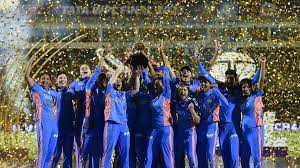
Given that foreign players dominated both the run-scoring and wicket-taking charts, choosing only four was an incredibly tough exercise, with the likes of Marizanne Kapp and Sophie Ecclestone missing out.
How often does the hype match reality, or even exceed it? We know the answer to that. Before the Women’s Premier League (WPL) began, we were told: “Ye Toh Bas Shuruat Hai [This is just the beginning].” We couldn’t have known at the time that the first season’s finale would prove so thrilling, or that just over three weeks of cricket in one city would be enough to convince even the cynics that this league is here to stay.
Given the players in their squad, the Mumbai Indians’ victory could scarcely be called a surprise. But given that they did it without a single Australian player in their ranks will certainly raise an eyebrow or two, so emphatic has been the domination of the green-and-gold shirt over the past decade.
The Revsportz Team of the Tournament reflects just how two teams, Mumbai and Delhi, dominated the tournament. Gujarat and UP find one representative each, and there is no one from a Bangalore side that was heavily fancied before the competition began.
There were some incredibly tough calls to make as well. Marizanne Kapp has been among the world’s best all-rounders for a decade. Sophie Ecclestone is the No.1-ranked bowler in the format, and finished joint-top of the wicket-takers’ list in the WPL. Tahlia McGrath smashed four half-centuries, more than anyone else.
But how do you leave out Meg Lanning, who won the Orange Cap for leading run-scorer without even being at her clinical best? And how can you possibly ignore the all-round potency of Hayley Matthews? Nat Sciver-Brunt was the only one to top 300 runs and 10 wickets, while Issy Wong was irresistible in the games that mattered most.
When picking a team of the tournament, you have to play by the rules, and that means only four foreign players. So, here are our choices, as tough as they were to make.
Meg Lanning (Delhi): You can’t really argue with 345 runs at an average of nearly 50, and a strike-rate of 139. Her captaincy kept Delhi in it till the very last, though it would be nice to see more emerging Indian talent getting a chance to play next season.
Shafali Verma (Delhi): None of the other leading run-scorers came close to matching her strike-rate (185.29). She struggled for fluency as the tournament progressed, but an experience like this will only help her to find that elusive consistency.
Hayley Matthews (Mumbai): Seven years ago, as an 18 year old, her brilliance blew Australia away in a World T20 final at Eden Gardens. These are much leaner times for West Indies Women, but Matthews was sensational in the WPL, contributing 271 runs and a chart-topping 16 wickets. Only Shafali and Sophie Devine hit more than her tally of 10 sixes.
Nat Sciver-Brunt (Mumbai): She is a cricketing force of nature. Second only to Lanning with 332 runs at a strike-rate of 140, she also chipped in with 10 wickets at an economy rate of 7.12. Famed for her big hitting, she knuckled down and played the anchor role to perfection in a tense run chase in the final.
Harmanpreet Kaur (Mumbai, C): She contributed just 101 runs in the last five games, but her storming start to the season played a huge part in building the momentum that carried Mumbai through the competition. Don’t underestimate either the value of the 37 in the final, coming as it did when Mumbai were struggling in pursuit of a modest target. Her calm and controlled leadership was just as pivotal in the trophy triumph.
Yastika Bhatia (Mumbai, WK)): Her batting form deserted her a little in the second half of the season, but a return of 214 runs is not to be scoffed at. Her glovework was steady and often superb, with more stumpings (7) than catches (6) reflecting just how alert she was behind the stumps.
Dayalan Hemalatha (Gujarat): A veteran of the domestic circuit, she scored 51 runs fewer than Harleen Deol, but her strike-rate of 157.29 was better by only five other players who topped 100 runs for the season. In her final outing of the season, she upstaged the brilliant Ashleigh Gardner with a sensational 33-ball 57.
Issy Wong (Mumbai): She isn’t just scarily good for a 20 year old. She’s also lucky. All three wickets in the final came from full tosses, a couple of which might have been no-balled if we didn’t have access to such precise tracking technology. The best players, however, make the most of the luck that comes their way, and Wong turned it on when it really mattered. Before her final intervention, she had destroyed UP Warriorz with a hat-trick and 4-15 in the Eliminator.
Shikha Pandey (Delhi): Nearly 34, she has been sometimes an afterthought in recent seasons. But in the WPL, she showcased her value with 10 wickets at an outstanding economy rate of 6.59. Without her 17-ball 27 from No.8, the final might have been a one-sided rout.
Rajeshwari Gayakwad (UP): She took 7 wickets from eight matches at an economy rate of 8.20. Her selection is also a reflection on how poorly some of the leading Indian bowlers performed. Parshavi Chopra, full of teenage exuberance, created a ripple when given a chance, but by and large, there wasn’t much to celebrate.
Saika Ishaque (Mumbai): That she took 12 wickets in the first four matches, and just three in the remaining six suggests that team analysts and batters figured her out to an extent. But those initial spells took Mumbai to the top of the log, and showed just how confident she was against the world’s best batters. If she can add a few more variations, she can prove that this wonderful season was no flash in the pan.
Good article